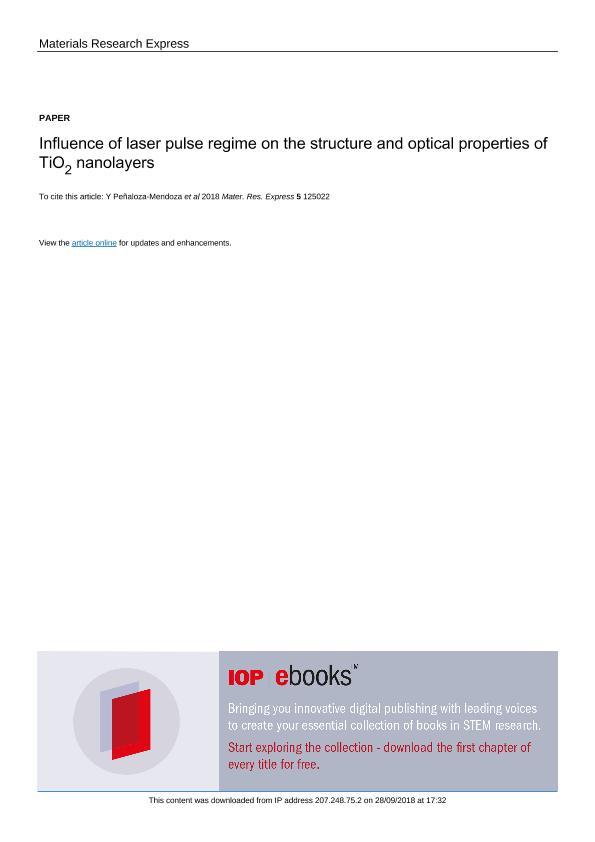Mostrar el registro sencillo del ítem
dc.contributor.author
Peñaloza Mendoza, Y.
dc.contributor.author
Alvira, Fernando Carlos

dc.contributor.author
Caballero Briones, F.
dc.contributor.author
Guarneros Aguilar, C.
dc.contributor.author
Ponce, L.
dc.date.available
2019-08-30T18:48:40Z
dc.date.issued
2018-12
dc.identifier.citation
Peñaloza Mendoza, Y.; Alvira, Fernando Carlos; Caballero Briones, F.; Guarneros Aguilar, C.; Ponce, L.; Influence of laser pulse regime on the structure and optical properties of TiO2 nanolayers; IOP Publishing; Materials Research Express; 5; 12; 12-2018; 125022-125031
dc.identifier.issn
2053-1591
dc.identifier.uri
http://hdl.handle.net/11336/82639
dc.description.abstract
TiO2 films were deposited onto glass substrates by pulsed laser deposition (PLD) in high vacuum under monopulse and multipulse excitation. After deposition, a thermal treatment on air atmosphere was done to promote crystallization. Films were studied by x-ray diffraction, energy dispersive spectroscopy, scanning electron, atomic force microscopy, UV-vis spectroscopy, and ellipsometry. After air annealing, films gain a different amount of oxygen: TiO1.9 in multipulse regime versus TiO1.7 in the monopulse one. Splashing is observed in both regimes although in the multipulse mode greater particles are found, that derived in a less compact film after annealing which could be the cause of the better oxygen diffusion. The optical band gap of the film prepared with monopulse excitation is 3.09 eV. This value increased to 3.34 eV with annealing, corresponding to that of anatase. The film made with multipulses has an Eg = 3.12 eV which was invariant upon annealing. The difference in the properties of the films grown in the different regimes was attributed to the re-excitation of the plasma during the ablation process in the multipulse ablation that leads to an increased splashing density and thereafter a less compact film and the presence of off-stoichiometry inclusions within the film bulk.
dc.format
application/pdf
dc.language.iso
eng
dc.publisher
IOP Publishing

dc.rights
info:eu-repo/semantics/openAccess
dc.rights.uri
https://creativecommons.org/licenses/by/2.5/ar/
dc.subject
Multipulse And Monopulse Regimes
dc.subject
Pulsed Laser Deposition
dc.subject
Tio2
dc.subject
Tio2 Air Annealing
dc.subject
Tio2 Optical Properties
dc.subject
Tio2 Structure
dc.subject.classification
Recubrimientos y Películas

dc.subject.classification
Ingeniería de los Materiales

dc.subject.classification
INGENIERÍAS Y TECNOLOGÍAS

dc.title
Influence of laser pulse regime on the structure and optical properties of TiO2 nanolayers
dc.type
info:eu-repo/semantics/article
dc.type
info:ar-repo/semantics/artículo
dc.type
info:eu-repo/semantics/publishedVersion
dc.date.updated
2019-08-08T16:10:14Z
dc.journal.volume
5
dc.journal.number
12
dc.journal.pagination
125022-125031
dc.journal.pais
Reino Unido

dc.journal.ciudad
Bristol
dc.description.fil
Fil: Peñaloza Mendoza, Y.. Instituto Politécnico Nacional; México
dc.description.fil
Fil: Alvira, Fernando Carlos. Universidad Nacional de Quilmes. Departamento de Ciencia y Tecnología. Laboratorio de Biomembranas; Argentina. Consejo Nacional de Investigaciones Científicas y Técnicas. Centro Científico Tecnológico Conicet - La Plata; Argentina
dc.description.fil
Fil: Caballero Briones, F.. Instituto Politécnico Nacional; México
dc.description.fil
Fil: Guarneros Aguilar, C.. Instituto Politécnico Nacional; México
dc.description.fil
Fil: Ponce, L.. Instituto Politécnico Nacional; México
dc.journal.title
Materials Research Express
dc.relation.alternativeid
info:eu-repo/semantics/altIdentifier/url/https://iopscience.iop.org/article/10.1088/2053-1591/aae2e5
dc.relation.alternativeid
info:eu-repo/semantics/altIdentifier/doi/https://doi.org/10.1088/2053-1591/aae2e5
Archivos asociados
